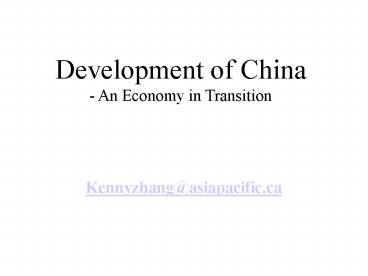Development of China - An Economy in Transition - PowerPoint PPT Presentation
Title: Development of China - An Economy in Transition
1
Development of China- An Economy in Transition
- Kennyzhang_at_asiapacific.ca
2
3 Purposes
- To Know China
- China matters
- To Know Chinas Development
- Development matters
- To Know Chinas Development Impacts on Us
- Are we prepared?
3
5 Topics
- Why China?
- Why development?
- What happened to Chinas development?
- What next? New challenge ahead
- Summary
4
1. Why China?
- 1.1 Facts
- Where? http//china.scmp.com/map/
- What? http//www.asiapacificbusiness.ca/background
ers/pages_contents.cfm?ID_Briefing1 - Country Comparisons http//www.asiapacificbusines
s.ca/backgrounders/compareIE.cfm
5
1. Why China? (contd)
- 1.2 Nicknames
- Awaken Dragon
- History Land Population Economy see 2.2.2.
- Growth Engine http//www.business-standard.com/u
pdates/news.asp?story3084 - GDP growth 7.6 (98-02) 3 times of world average
- Top FDI Recipient
- US52.7b/7 (2002), 57b (2003)
- Global Factory http//news.bbc.co.uk/2/hi/busine
ss/2415241.stm - Labour cost, production chain, export
- Threaten to the World
- Domestic crisis (population, energy, food,
economy) global integration (trade, currency)
rising powerful state (economy and military)
6
2. Why Development?
- 2.1 Long term trend
- 2.2 Chinas position past present
7
2.1 Long-run of Economic Growth- Selected
Countries
8
2.2 Chinas Development Position
- Fast growth
- Large scale
- Low level
- Source http//www.adb.org/Documents/Books/Key_Ind
icators/2003/default.asp
9
2.2.1 GDP and GDP Per Capita Growth Rate (PPP)
1700-1995
10
2.2.2 Share of GNP (PPP)
11
2.2.3 GDP Per Capita (PPP) 1700-1995
12
Source MOFCOM, China, at http//www.mofcom.gov.cn
/table/jcktj/lszl/lszlqxt.html
13
3. What Happened?
- Economic Reform
- Transition to the market
- Global Integration
14
3.1 History of Chinas Development
- First Five-Year Plan (1953-1957)
- A new economic order modeled on the Soviet Union
example, emphasizing the development of
capital-intensive heavy industry - Great Leap Forward (1958-1960)
- The break away from the Soviet model and
introduction of a new program aimed at rapidly
raising industrial and agricultural production - Cultural Revolution (1966-1976)
- The pursuit of Maos own development strategy of
a self-reliant economy and political struggle - Economic Reforms (1978- )
- To move the economy from a planned economy to one
that is more market-oriented
15
3.2 Economic Reforms
- Rural reform
- Increase of agricultural production and rural
income - Open-door policy
- Turnaround from an inward-looking, self-reliant
economy to one that participates in the world
economy (foreign trade, FDI, and SEZs) - Industrial reform
- Enterprise reform and price reform
- Financial reform
- Companys responsible for financial performance
and borrow money from banks raise capital at the
stock market
16
3.2 Economic Reforms (Contd)
- SOEs reforms
- Ownership/Assets restructuring
- Western China development
- Regional development
- WTO accession
- Trade policy change, legal reform, structure
adjustment - Go Global strategy
- Outward investment, cross-board MAs, overseas
listing
17
3.3 Model of China Development
- 1 Socialist planned economy
- Government planning is basic means of allocating
resources - Production quotas quantity rather than quality
- Suppress consumption to increase saving invest
in heavy industry - Self-reliant and uninvolved in foreign economic
relation - Results
- Shortage in supply production and consumption
goods - Slow and unstable economy growth
18
3.3 Model of China Development (contd)
- 2 Socialist market economy
- Market is basic means of allocating resources
- State controls at the macroeconomic level
- Economic structural Reform
- Results
- Competition establishment of the diversified
ownership - Efficient profit maximization
- Open involved in foreign economic relation
- Fast economy growth
19
Comparison of Two Development Models
20
4. New Challenges Ahead
- Population and environmental pressures
- Employment insecurity
- Growing inequality and poverty
- Macroeconomic instability stemming from
incomplete reforms/transitions - International player economically and politically
21
4.1 Population and Environmental Pressures
- Large in (1.3 b)
- Low rate (lt1)
- Low urbanization (30)
- Migrant labour (100 million)
22
4.2 Employment Insecurity
23
4.3 Growing Inequality Per Capita Annual Income
of Urban and Rural Household and The Related Index
24
5. Summary
- China matters in many ways
- A faster developing China is better off for all
- China strategy is a must































